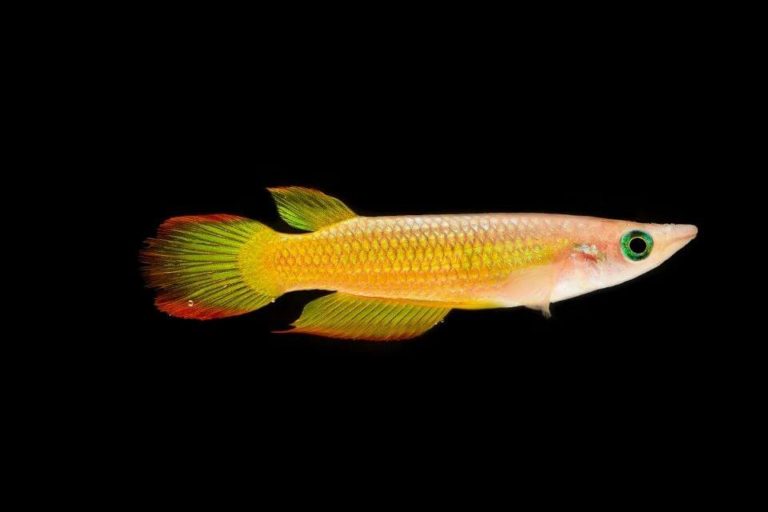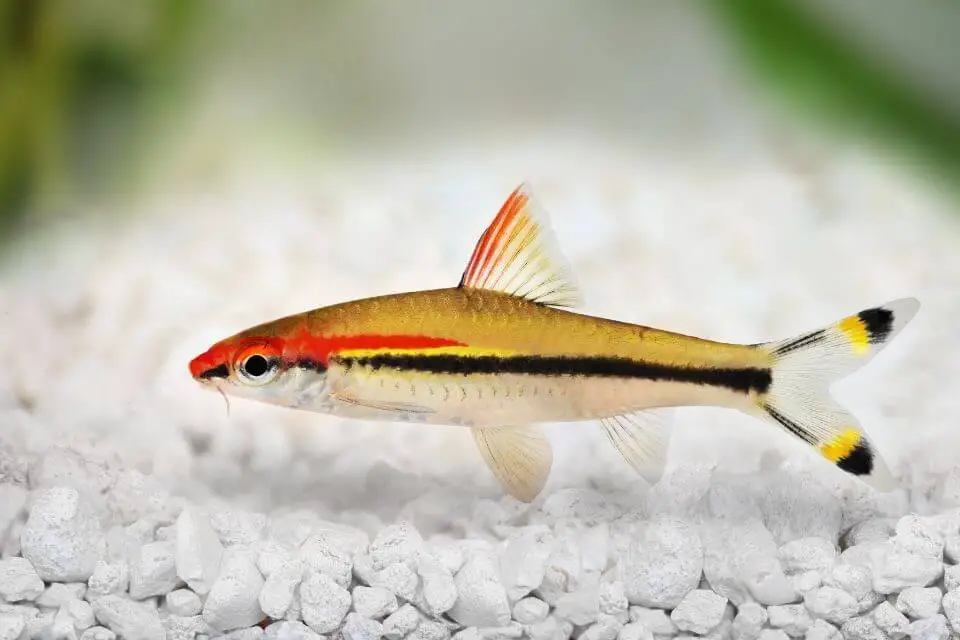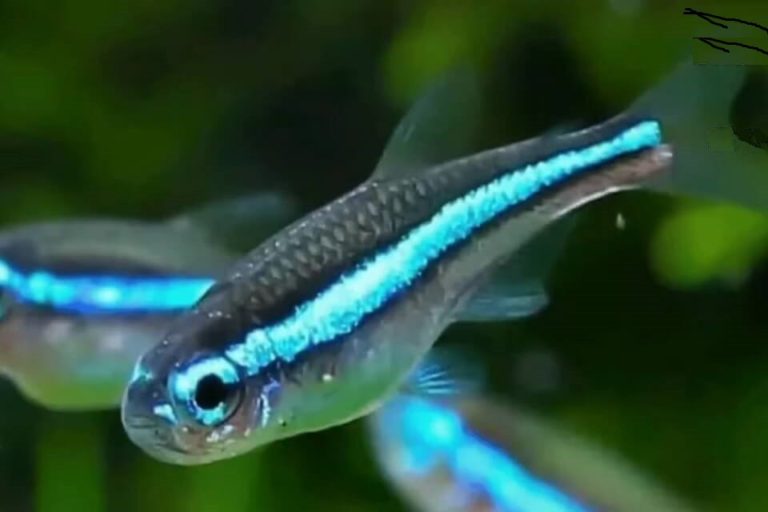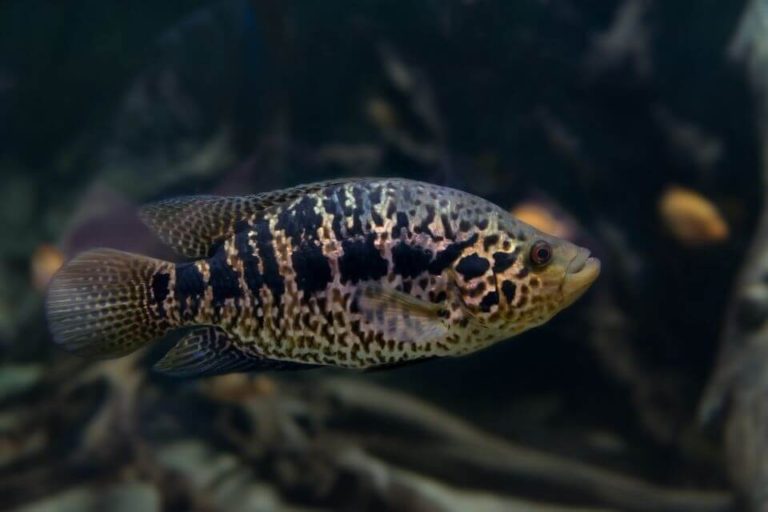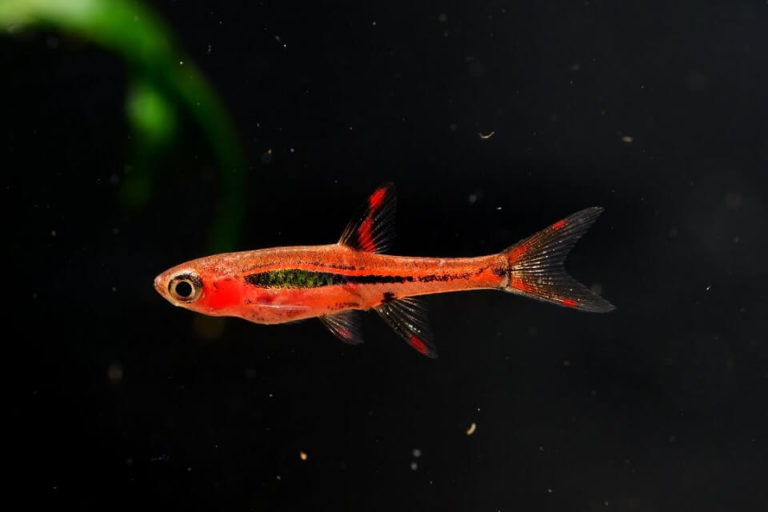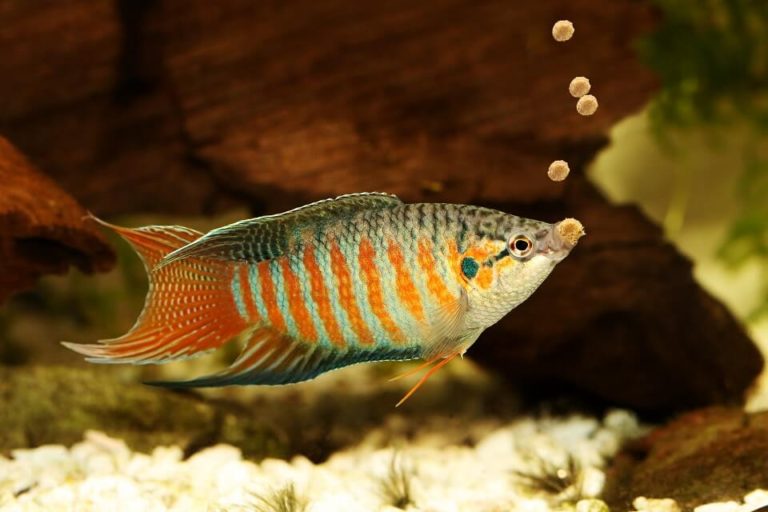Keyhole Cichlid Care: Tank Mates, Tank Size, Food & Breeding
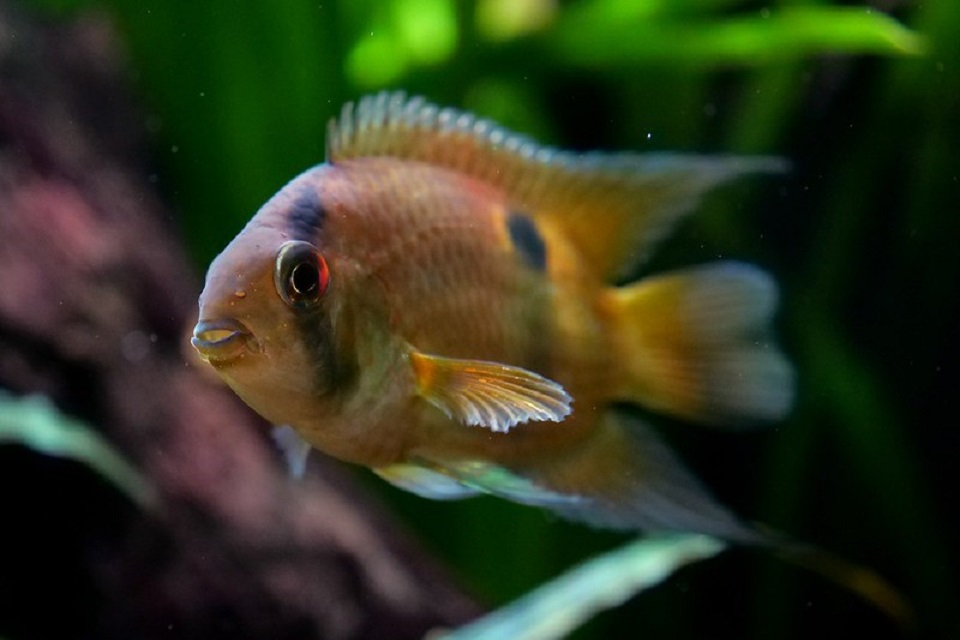
Keyhole Cichlid is a unique species of freshwater fish native to South America that make an excellent addition to many home aquariums.
These intelligent, small-sized fish have flowing color patterns and distinctive black markings around their eyes like keyholes, which gives them their name.
Their curious nature and easy maintenance requirements make for exciting entertainment for beginner aquarists and experienced hobbyists alike!
This guide will discuss the basics of keeping a healthy keyhole cichlid tank, including water parameters, diet considerations, and the essentials of tank setup.
You’ll also learn about the fascinating social dynamics of these intriguing little carnivores and some other fun facts – so read on to find out more!
Keyhole Cichlid Overview
Keyhole cichlids are small, peaceful fish that are native to South America. These beautiful freshwater aquarium fish come in a wide range of vibrant colors, including orange, yellow, red, blue, and green, with black markings around their eyes.
Keyhole cichlids make for excellent pets thanks to their relatively easy maintenance requirements and fascinating social behaviors.
Regarding water parameters for keyhole cichlid tanks, it is essential to maintain stable pH levels, temperature, and hardness. Keyhole cichlids are adaptable to these factors and can thrive in tanks with a pH range between 6.0 to 8.0.
When it comes to temperature, they prefer warmer water, with a range between 72 to 78 degrees Fahrenheit.
Keyhole cichlids also do best in tanks with moderate hardness levels, so it is essential to use a good quality aquarium water conditioner to help maintain these parameters.
Keyhole Cichlid Size
The size of the Keyhole cichlid varies from 4 to 5 inches in length, depending on the gender. Males reach a maximum of 5 inches in length, whereas females generally don’t grow beyond 4 inches in size.
Keyhole cichlids can reach sexual maturity as early as three months old, though it is recommended that you wait until they are around 5 inches in size to ensure proper breeding.
Keyhole Cichlid Lifespan
In the wild, Keyhole cichlids can live up to 10 years on average. In captivity, however, they generally have a shorter lifespan of between 4 to 6 years.
This is due to the stress of being in an aquarium environment and the nutritional deficiencies that occur when they are fed low-quality foods or not given enough variety in their diet.
To keep your Keyhole cichlid happy and healthy in your aquarium, it is crucial to provide them with a varied diet that includes a combination of high-quality dry foods, live foods like worms or crickets, and fresh greens like spinach or zucchini.
Additionally, you must maintain good water quality through regular tank cleanings using an adequate filtration system and frequent water changes.
With proper care, Keyhole cichlids can thrive in your aquarium and provide you with hours of enjoyment as they explore their new home!
Keyhole Cichlid Colors And Appearance
One main characteristic that makes Keyhole cichlids a popular choice for aquariums is their beautiful and varied color patterns.
The color variations of the keyhole cichlids make them gorgeous fish. The colors are extensive, ranging from bright oranges to deep blues and greens with black markings around their eyes like keyholes.
Depending on the individual fish, you might find other colors like yellow or red mixed in for added variety. The keyhole pattern is usually more prominent in younger fish but will fade as they age.
In addition to their unique color variations, Keyhole cichlids tend to have exciting body shapes and patterns. They have elongated bodies with pointed heads and long tails slightly pointed at the end.
Some individuals may even have a white stripe running down the center of their body from head to bottom, making them look almost iridescent in certain lights.
Behavior & Temperament
Among all freshwater aquarium fish species, the behavior of Keyhole cichlids is often considered one of the most difficult to manage in captivity.
Keyhole cichlids are naturally aggressive and territorial fish, which can make them prone to attacking other tank inhabitants or engaging in harmful dominance displays.
The intelligent and curious nature of Keyhole cichlids makes them very entertaining, especially when housed in a community tank aquarium setup.
These fish are known to be very active swimmers and often spend hours performing intricate food-catching or territorial displays.
They may also engage in “kissing” behavior where they gently nudge each other on the lips or fins as a form of communication within their social group. Keyhole cichlids make great pets due to their peaceful temperament and interesting natural behaviors!
Keyhole Cichlid Care
If you are interested in adding Keyhole cichlids to your freshwater aquarium, it is essential to understand the proper care requirements for these fish.
Care
Caring for this colorful fish is essential to ensure it enjoys a happy life. The keyhole cichlid is native to the waters of the Amazon River basin and feeds on small insects, crustaceans, and spirulina in its natural habitat.
An aquarium of at least 30 gallons with a planted substrate and plenty of hiding spots should be provided for your fish.
Keyhole Cichlid Tank Setup
To set up an ideal Keyhole cichlid tank, choose the right size and shape for your aquarium. Keyhole cichlids are relatively small fish, so keeping them in at least a 30-gallon tank with plenty of room for swimming and exploring is recommended.
To set up a tank for keyhole cichlids, you’ll need to consider several factors, including a substrate, lighting, water filter, and decorations such as rocks, caves, and driftwood.
Here’s what you need to know about setting up the perfect keyhole cichlid tank.
Substrate: A sandy substrate should be used in the keyhole cichlid tank. This will help buffer the pH levels of the water to make it more comfortable for your fish. You can also add some larger rocks or gravel.
The bottom of your aquarium should be kept clean since these fish like to dig around in the sand, looking for food.
Lighting: Keyhole cichlids enjoy natural light from windows or indirect sunlight from aquarium lamps. However, the light must be moderate as this can cause stress in your fish. Depending on what works best for your tank setup, you can use fluorescent or LED lights.
Water Filter: A high-quality water filter is essential for any aquarium with keyhole cichlids. This will help keep your tank clean and free of debris so that your fish can live happily and healthily without having to worry about toxins building up in the water.
A hang-on-back (HOB) filter is usually recommended since they are easy to install and maintain.
Decorations: Rocks, caves, driftwood, and plants significantly add to any keyhole cichlid tank setup. These decorations offer places where your fish can hide if they feel stressed or threatened.
Also, provide space for them to explore and play around with one another when they feel comfortable enough.
Make sure that any decorations you choose are safe for aquariums so that they don’t contain chemicals that may harm your fish over time due to exposure through the water column or leaching into the substrate itself.
Driftwood is especially beneficial since it helps reduce nitrates which can become toxic if levels get too high over time!
Water Parameters And Testing
To give your keyhole cichlids the best care possible and help them thrive in an aquarium, you must regularly monitor and maintain their water parameters.
Keyhole cichlids are sensitive to changes in temperature, pH levels, and oxygen content in the water, so it is crucial to test these parameters regularly using tools such as test strips or liquid testing kits.
Temperature: Keyhole cichlids prefer warm water with temperatures ranging from 70-80 degrees F (21-26 degrees C). Monitor this regularly and use a heater if necessary to keep the tank at an appropriate temperature for your fish.
pH: Keyhole cichlids thrive best in slightly acidic water with a pH level between 6.0 and 7.5. If the pH of your tank becomes too high or low, you can use additives to help increase or decrease it as needed.
Try to keep an eye on this parameter and make adjustments as necessary to ensure that your keyhole cichlids are living in optimal conditions for their health and well-being.
Oxygen: Keyhole cichlids thrive best in well-oxygenated water, so make sure to keep your tank manageable with enough fish at a time, which will limit air circulation through the water column itself.
You can also add an aerator or oxygen pump if necessary to help keep the water circulating and provide sufficient oxygen content for your fish.
With proper care and attention, keyhole cichlids can make wonderful aquarium pets that provide hours of enjoyment for their owners.
They are an excellent choice for both beginners and more experienced aquarists, so if you’re looking for a peaceful, friendly fish to add to your freshwater tank, a keyhole cichlid may be just what you need!
Suitable Aquarium Plants
Various plants can be used in the tank of this most colorful freshwater fish (keyhole cichlid) to help create the perfect environment for your fish. Some of the most popular options include:
Java Fern: Java Ferns are a popular choice in any freshwater aquarium because they’re easy to care for and tolerant of most water conditions. They require low lighting and no additional fertilization, so they’re ideal for beginners.
The leaves of java ferns can provide hiding spots for smaller fish like keyhole cichlids and protection from more aggressive fish.
Anubias Barteri: Anubias barteri is another excellent choice for a keyhole cichlid tank because it can tolerate challenging water conditions and intense lighting.
It does not require supplemental fertilization or CO2 injection, making it an ideal low-maintenance plant for beginners. Anubias barteri also provides plenty of hiding spots for keyhole cichlids and other smaller fish.
Plus, its thick root structure helps prevent substrate shifting and erosion in the tank.
Dwarf Hairgrass: Dwarf hair grass is an attractive carpet-like plant that proliferates in tanks with high light levels and CO2 injection systems.
Its dense growth provides plenty of cover for small fish like keyhole cichlids while also helping to keep the water clean by absorbing nutrients from the substrate.
However, dwarf hair grass requires regular trimming to keep it looking its best and maintain its growth rate.
Cryptocoryne wendtii: Cryptocoryne wendtii is an ideal choice for tanks with medium lighting levels because it doesn’t need too much light or CO2 injection to thrive.
This slow-growing plant produces beautiful deep green leaves, which add texture and color to any aquascape while providing plenty of cover for small fish like keyhole cichlids.
Its tough root structure helps prevent substrate shifting in the tank; however, cryptocoryne wendtii requires regular trimming to keep it looking its best.
Green Cabomba: Green Cabomba is a fast-growing plant that produces beautiful bright green foliage which adds texture and color to any aquascape while providing plenty of cover for small fish like keyhole cichlids.
This plant requires high light levels and supplemental fertilization or CO2 injection to grow correctly; however, once established, green Cabomba can tolerate most water conditions without too much difficulty, making it a relatively low-maintenance option compared to other aquarium plants on this list.
Common Diseases And Prevention
Some of the most common diseases that can affect keyhole cichlids include:
Hole in the Head Disease: Also known as HITH or head and lateral line erosion (HLLE), this disease is relatively common among keyhole cichlids and other freshwater fish.
It causes small lesions to develop on the head and lateral line of the fish, which can lead to infection and even death if left untreated. There is no treatment for HITH, so it’s essential to take preventative measures to keep your keyhole cichlids healthy and free from this disease.
Some prevention tips include maintaining good water quality by performing regular water changes, keeping the tank well-lit to promote healthy biological processes, and feeding a varied diet that provides high-quality and live or frozen foods.
Ich: Also known as white spot disease, ich is caused by an infestation of the parasite Ichthyophthirius multifiliis. This parasite attacks the gills and skin of the fish, causing small white spots to develop on their body.
Keyhole cichlids are especially susceptible to this disease due to their natural territorial behavior and sensitive skin, so it’s essential to take preventative measures to keep your keyhole cichlids free from this nasty parasite.
Some prevention tips include maintaining good water quality by performing regular water changes and keeping the tank well-lit, as ich is sensitive to temperature changes.
Additionally, it’s essential to be careful when introducing new fish into a tank, as they may carry ich without showing any symptoms.
Fungal Infections: Fungal infections can occur when a keyhole cichlid is exposed to poor water quality, high levels of stress, or physical injuries.
Some common symptoms of fungal infections include lethargy, loss of appetite, discoloration and spotty marks on the fish’s body, and open sores or ulcers on their skin.
Keyhole cichlids are especially prone to fungal infections due to the specific conditions in which they thrive best;
Therefore, it’s essential to take preventative measures such as maintaining good water quality by performing regular changes and keeping your tank well-lit.
Additionally, providing a healthy diet with plenty of live or frozen foods can help boost your keyhole cichlid’s natural immunity, which can help prevent the onset of fungal infections.
Fin Rot: Fin rot is a common problem that can affect keyhole cichlids and other freshwater fish. It is caused by poor water quality or low temperatures and often results in the development of small white spots on your Keyhole Cichlid’s fins.
If left untreated, fin rot can lead to more severe infections, such as secondary bacterial infections, requiring antibiotics for treatment.
The best way to prevent fin rot from affecting your Keyhole Cichlid is to ensure good water quality and avoid exposing them to sudden changes in temperature.
Additionally, give your Keyhole Cichlid a varied diet with plenty of live or frozen foods to help keep their immune system strong, which can help protect them from infections.
Keyhole Cichlid Food And Feeding
Keyhole cichlids are omnivorous fish, meaning they eat plant- and animal-based foods to meet their nutritional needs. In the wild, Keyhole Cichlids naturally feed on small insects, other invertebrates, and algae and plant matter.
In the aquarium setting, Keyhole cichlids can be fed various foods to meet their nutrient needs. A good staple diet for Keyhole Cichlids includes high-quality flake or pellet foods, which should make up most of their diet.
It’s also essential to have live or frozen insect larvae, bloodworms, brine shrimp, and other similar foods to provide your Keyhole Cichlids with a more natural, protein-rich diet.
To keep your Keyhole Cichlid healthy and happy, it’s essential to feed them a varied, nutritious diet regularly. This will help ensure they stay strong and active while minimizing the risk of common health problems like fin rot or fungal infections.
Keyhole Cichlid Male Vs. Female Difference (Gender)
One of the most common questions aquarium enthusiasts have regarding Keyhole Cichlids is whether they are male or female.
Keyhole cichlids exhibit various physical characteristics depending on their gender, and determining the difference can sometimes be difficult without the proper expertise.
Generally, Keyhole Cichlid males tend to be significantly larger than females, with more brightly-colored and vibrant markings.
Keyhole cichlid females also tend to be slightly plumper than males, which is thought to be an evolutionary trait that helps them store eggs and provide protection for their young after they are born.
Additionally, Keyhole Cichlid males typically have more extended fins than females, which makes it easier to distinguish between the two genders.
If you are unsure whether your Keyhole Cichlid is male or female, it’s best to consult a professional or experienced aquarium hobbyist for help.
A professional can provide you with expert guidance on Keyhole Cichlid care and help determine the gender of your fish so that you can provide them with the best possible environment and care going forward.
Breeding Keyhole Cichlid
Keyhole cichlids are relatively easy to breed in the home aquarium setting, making them an excellent option for novice fish keepers.
Keyhole cichlid breeding typically involves creating a suitable tank environment that mimics their natural habitat and provides them with plenty of nutritious food and clean, warm water.
To successfully breed Keyhole cichlids in an aquarium, you must set up your tank with plenty of live plants or other spawning sites. Keyhole cichlids often lay their eggs on rocky surfaces, so rocks or even small PVC pipes can make ideal breeding sites.
It’s also important to include lots of plant matter in your aquarium setup, as Keyhole cichlids consume a lot of algae and plant matter in the wild.
In addition to providing a suitable tank environment, Keyhole cichlid breeding also requires regular feedings with plenty of high-quality protein sources like bloodworms or brine shrimp.
Keyhole Cichlids should be fed at least twice per day while actively breeding, which will help ensure that their eggs receive the nutrients they need to develop correctly.
With careful planning and care, Keyhole cichlid breeding is an easy and rewarding experience for aquarium enthusiasts of all skill levels. Suppose you’re new to Keyhole cichlids or freshwater aquarium fish keeping in general.
In that case, it’s a good idea to do some research and talk to an experienced hobbyist for guidance before you start.
Keyhole Cichlid Tank Mates
When it comes to Keyhole cichlid tank mates, there are a few things to take into consideration. Keyhole cichlids can be aggressive fish that can sometimes get territorial and attack or harm other fish in their tank.
Ideally, Keyhole cichlid tank mates should be relatively peaceful and hardy fish that can tolerate the high temperatures and pH levels of a Keyhole cichlid aquarium.
Some good options include:
It’s important to always do plenty of research about different potential Keyhole cichlid tank mates before adding them to your aquarium, as some species may be more sensitive or aggressive than others.
Additionally, it’s vital to always quarantine new Keyhole cichlid tank mates before adding them to your existing tank population, which will help prevent the spread of disease or illness.
Origin And Distribution
Keyhole cichlids are native to the freshwater streams and rivers of South America. They can be found in various habitats, from slow-moving rivers with plenty of overhanging vegetation to faster-flowing streams with sandy and rocky bottoms.
Keyhole cichlids are schooling fish that tend to form large groups or shoals, which helps them stay safe in less hospitable environments. These fish species have been introduced into several different areas worldwide as ornamental fish species.
While they can be challenging to care for and manage in captivity, Keyhole cichlids have become popular among aquarists due to their bright colors, hardy nature, and generally peaceful demeanor.
Keyhole cichlids are now found in freshwater aquariums around the globe, as well as in natural waterways where they have become an invasive species.
FAQs
Are Keyhole Cichlids Aggressive?
They’re not aggressive fish but can become territorial in a community fish tank setting.
In the wild, Keyhole Cichlids are found in schools and typically get along well with other fish. But when they’re kept in a smaller aquarium with limited space, they may become territorial and aggressive towards other fish.
Do Cichlids Prefer Sand Or Gravel?
Cichlids prefer sand substrate because it is softer on their barbels, which they use for feeding. Gravel can wear down the barbels over time.
How Much Does A Keyhole Cichlid Cost?
Generally, a keyhole cichlid will cost anywhere from $9 to $13 in the US aquarium market, depending on the size and type of fish.
Conclusion
We hope you enjoyed our article about Keyhole Cichlid care.
If you are new to the Fishkeeping hobby and looking for a fish species that would give you an exciting experience then the Keyhole Cichlid fish make an excellent addition to many home aquariums.
These medium-sized fish have some unique features that make them ideal for enthusiasts!
Keyhole cichlids require a high temperature and pH level in their tank and plenty of room to swim and socialize.
While Keyhole cichlids can be challenging to care for, they are also beautiful and rewarding freshwater aquarium fish, making them popular among hobbyists.
If you are interested in learning more about different fish species and fishkeeping, you can continue visiting fishkeeping.com. We hope you find this article helpful and are excited to keep these fish in your home!


